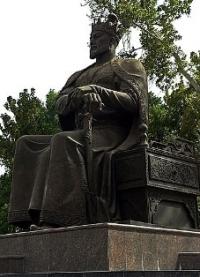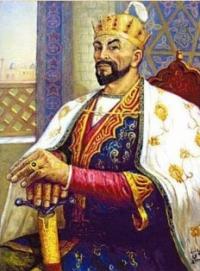You are here
Amir Temur.


Excursion tours to Uzbekistan and Central Asia.
“People usually feel funny, smile and laugh when I tell them
about my strong belief in the very existence of prehistoric
advanced technology and great civilizations of wilier races.
I just can't wait to see their faces at time the truth is revealed”
Toba Beta.
Excursion tours to mausoleum Gur-Emir in Samarkand.
Amir Temur (1336 - 1405) was born in Kesh (Shahrisabz), in a family of Barlas beg - Taragai. Amir Temur had epithet “Sahibkiran” – “born under happy constellation of two stars”, what was considered lucky according to oriental astrology.
By the time of Moguls’ invasion in 1360, Amir Temur, had already been one of the most authoritative begs in Maverannahr.
Mogul khan Toklug-Temur entrusted Sahibkiran to govern Kesh and Barlas lands. In 1361 - 1365, allied with emir Hussein, Amir Temur started the struggle against Moguls for Chagatai ulus. By 1370, influence and authority of Amir Temur had become so significant, that the most of Maverannahr emirs recognized him a supreme governor.
Taking into account bigness of his realm, Sahibkiran transferred the capital to Samarkand. Babur informed that “… before Temur-beg, none of the great sovereigns equal to him declared Samarkand a capital”. Defensive walls encircled rabad (outer city), which successfully sustained assaults of the Jalairs in 1375 and Juchids of Tokhtamish in 1387. In 1371 - 1372, the citadel was built in the western part of the city. It formed the inner city.
Two big four-storey buildings were constructed: Kok-serai (state treasury, workshops and prison) and Buston-serai - a royal residence. In this way, Amir Temur not just formed additional defense line, but augmented his power over liberty-loving Samarkand people.
In the yard of Gur-Emir there is a rectangular stone block, decorated with exquisite carving. Local legends say that this is a pedestal of Amir Temur’s throne from the lost palace of Kok-serai. Successful campaigns to Khorezm, Iran, Gold and White Horde, to the Caucasus, Near East and India very soon extended borders of the state.
For several years, Temur had been preparing his campaign to China and started it at the end of 1404. However, the death at the beginning of 1405 interrupted his grandiose plans. Spanish ambassador Ruy Gonzalez de Clavijo, visiting Amir Temur's capital in autumn 1404, witnessed that Samarkand was bigger than Seville - the biggest Spanish city.
Clavijo informed: “The city bosoms in gardens and vines, which in some places occupy one and half league (about 9 km) in length, and in some other places - even two. The city is hidden among them. The gardens are crossed by streets and squares, very populated … “.
In memory of Central Asian peoples, Amir Temur remains the great statesman, whose will and spirit created world empire. For the peoples of Iran, Iraq, India, Near East, Caucasus and Turkey, he is a merciless conqueror, whose invasion caused huge humanitarian catastrophe.
In Europe, Amir Temur is honoured as a rescuer, who defeating Turks - Ottomans, delayed collapse of Constantinople for half-century, and smashing the Golden Horde, accelerated exemption of Russia and East Europe from Tatar-Mongol yoke.
In Muslim tradition, Amir Temur - "paladin of Islam", reviving dignity of the Islamic world. He is esteemed as the initiator of cultural Renaissance in Middle East, fully realized in cultural policy of the Temurids in the XV century, Shaybanids in the XVI century and Baburids (Great Moguls) in the XVI - XVII centuries.
Authority:
Alexey Arapov. Samarkand. Masterpieces of Central Asia. Tashkent, San’at. 2004.







